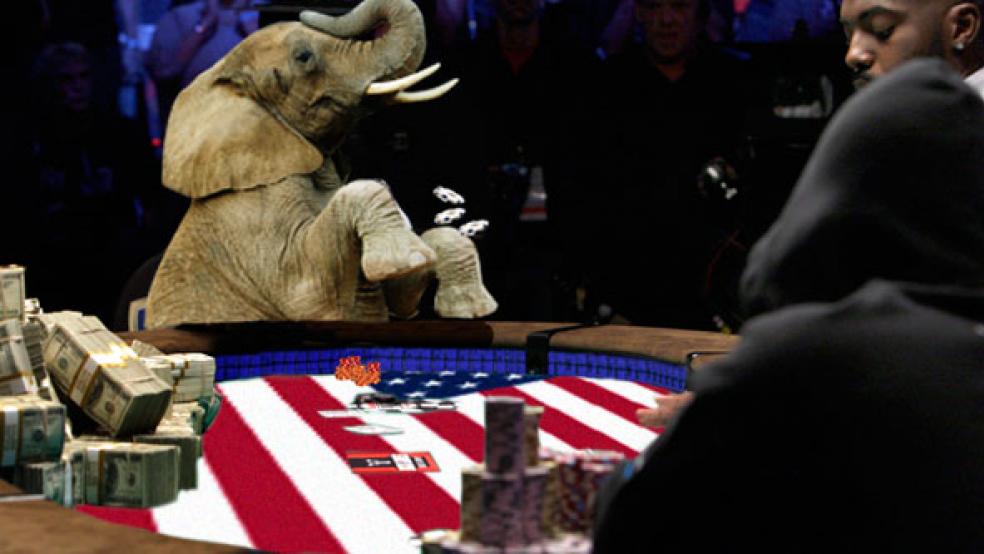As we head into yet another self-inflicted crisis over the national debt, does the potential harm from the debt justify the risky political tactics and potentially harmful brinksmanship that Republicans have used in negotiations over the debt ceiling, the fiscal cliff, the sequester, and whatever might come next? Is it possible that the artificial crises that Republicans have created during these negotiations pose a much greatest risk to our future economic growth than the debt itself?

It’s not only possible, it’s highly likely. Let’s begin with the economics. There are two main ways that government debt can cause economic problems. First, an increase in government debt can increase borrowing costs for everyone in the economy through the usual operation of supply and demand. The interest rate is the price of borrowing money, and when the demand for loans increases because the government is borrowing more, the price of loans – the interest rate – goes up.
This reduces spending on investment, consumer durables, housing, and other interest sensitive purchases, and the lower level of investment reduces future economic growth. But there are also benefits. An increase in deficit spending increases output and employment, and when the spending is on items such as infrastructure there is the further benefit of an enhanced potential for economic growth.
Near full employment the benefits of deficit spending are generally low and the costs are generally high, so this type of spending can be problematic, but the reverse is true during severe downturns. In a deep recession when people are struggling to make ends meet, the increase in output and employment from an increase in deficit spending is very valuable. At the same time, the costs are very low since there is usually an excess supply of funds – the money piling up in bank vaults and corporate coffers is an example of this – and government borrowing simply soaks up this excess, it does not put upward pressure on interest rates as it does near full employment. This makes it very likely that deficit spending in a deep recession will be a net positive, even more so for infrastructure spending due to its ability to increase our capacity for future economic growth.
The second potential problem is what a recent paper calls “tipping point dynamics.” In tipping point models, there is a threshold debt to GDP ratio of 80 percent to 90 percent. When economies cross this threshold interest rates can shoot up quickly and cause a government funding crisis and the potential for sovereign default. Thus, economies with debt levels in excess of the threshold can suddenly be thrown into turmoil and recession, and if this happens the result is unambiguously bad – there are no benefits to trade against lower future growth as there were in the case discussed above.
Republicans have been highlighting the possibility of interest rate spikes and sovereign debt default, it’s an opportunity to force spending cuts and realize their goal of a smaller government and lower taxes on the wealthy, but the risks aren’t anywhere near as large as we’ve been told. To see this, it’s important to separate countries like Greece and Italy who must repay their debt using currencies they don’t control from the countries like the US that have their debt denominated in their own currency.
Our debt is a promise to pay dollars, and unless we run out of trees for paper money or the electrons needed for digital money, we can meet those obligations. So long as creditors know they will get the money they are promised, the incentive for speculative runs that can cause so much trouble for a country like Greece is all but eliminated (and there is evidence supporting this view). This is not a recommendation to pay our debt by printing money, not at all – there are costs to this approach – it’s an explanation of why the fears of spiking interest rates and default on the debt differ substantially depending upon whether a country controls its own currency.
The fears of a sovereign debt promoted by those with other agendas are very much overblown. We have the economic resources we need to pay our bills, we’ve managed just fine with even higher debt burdens in the past, and as a last resort we can always print the money we need to meet our obligations. The real question is whether our politicians and political institutions are up to the task they face, particularly today’s Republican Party. Unfortunately, the answer suggested by the negotiations over the debt ceiling, the fiscal cliff, and the sequester is not encouraging.
If we have a crisis, the ability to pay our bills will not be the problem. It will be caused by politicians on the right gambling with the economy, and an inability to pull back from the brink of a self-inflicted crisis created in pursuit of political and ideological goals.






